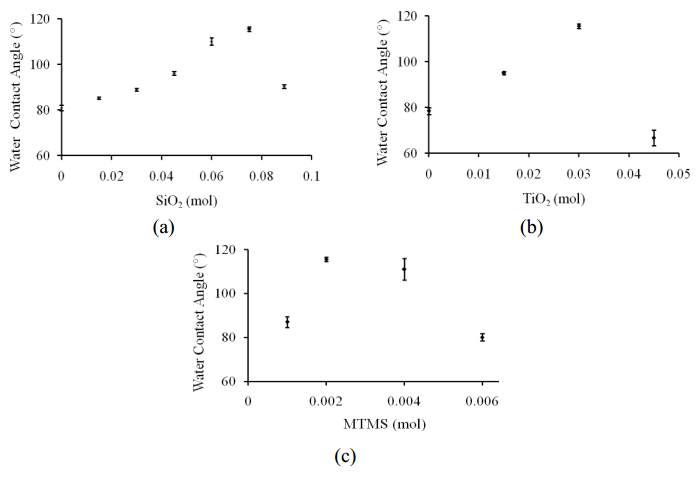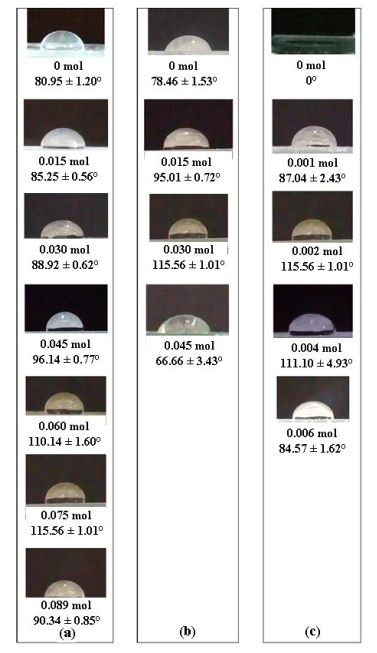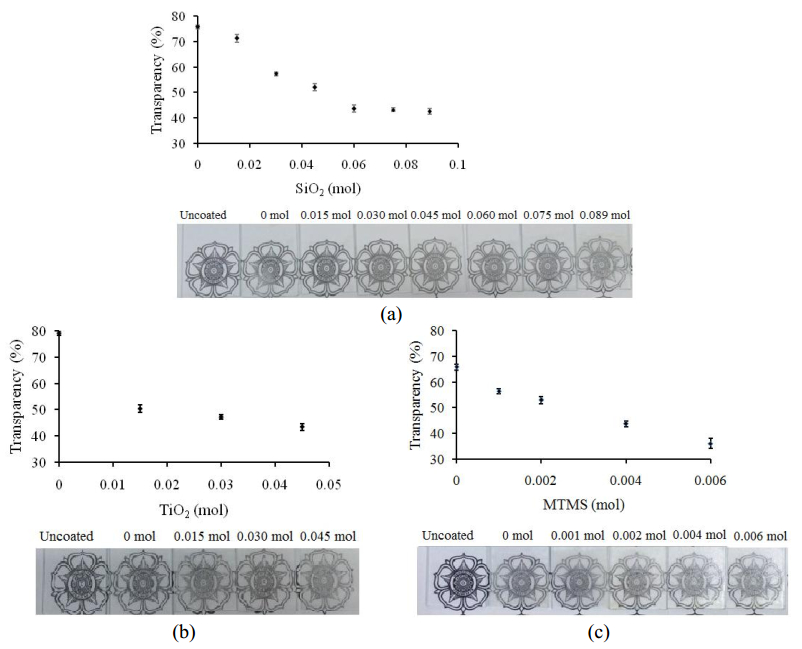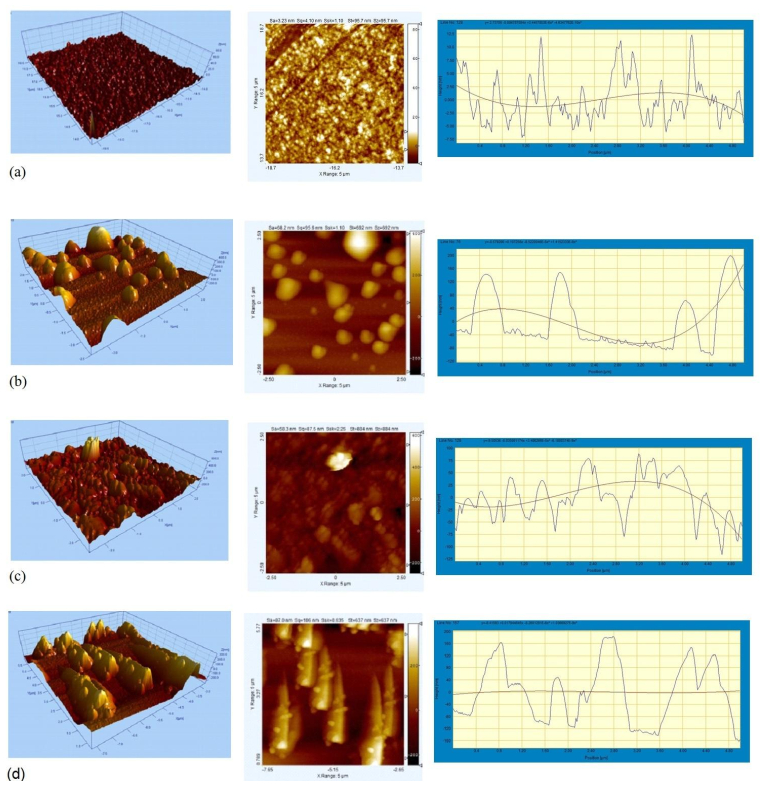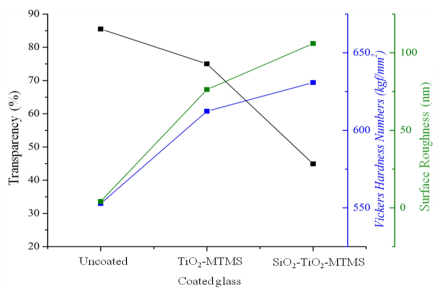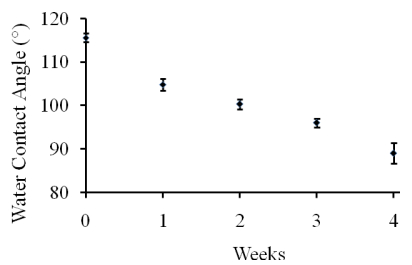1.
Introduction
Hydrophobic glasses are glasses with surfaces that exhibit water roll-off properties. Generally, the hydrophobicity of a glass is influenced by its surface energy and surface roughness [1]. Fluorosilane is the most frequently used low-surface-energy material. Unfortunately, fluorosilane is categorized as a toxic compound, and has been reported to be hazardous to human health and environment [2,3]. Recently, many authors have utilized alkylsilane as a milder alternative to fluorosilane that also has a low surface energy [4,5,6,7]. However, materials coated with alkylsilane exhibited lower water contact angles than those coated with fluorosilane. Coatings prepared using only alkylsilane also resulted in low water contact angles, i.e., low hydrophobicity. The coating of glasses with methyltrimethoxysilane (MTMS) also resulted in a low water contact angle; however, the angle was increased to 171 ± 1° by the addition of polymethylmethacrylate to the MTMS coating [8]. Another attempt to improve the hydrophobicity of a silica aerogel based on MTMS through modification with trimethylchlorosilane (TMCS) and cetyltrimethylammoniumbromide was reported [9].
Increasing the roughness of a surface can also enhance its hydrophobicity. This effect can be explained by the Wenzel and Cassie-Baxter equation. Wenzel stated that a rough surface has an actual surface area larger than its horizontal projection. The substitution of the actual surface area to the Young equation will provide the larger contact angle. Cassie-Baxter assumed that the rough surface is created by air entrapment in the gaps of the rough structure, so that the droplet rests on a layer of air [10,11]. A rough surface can be produced by the deposition of metal oxide on the surface. The agglomeration of the oxide generates some cavities on the surface, producing a rough structure. In previous studies, we have investigated the use of SiO2 nanoparticles, methyltrimethoxysilane, and hexadecyltrimethoxysilane to prepare hydrophobic glasses [12]. The prepared glasses were stable towards ethanol, but unstable at ambient temperature. The use of SiO2 nanoparticles in powder form decreased the transparency of the glasses. The use of a MTMS-modified SiO2 sol to coat soda lime glass resulted in high transparency, but its water contact angle was less than 90° [13].
In addition to SiO2, TiO2 has also been employed to produce rough surfaces [14,15,16]. Interestingly, the combination of TiO2 and hydrophobic agents results in tunable properties, i.e., the ability to switch the hydrophobicity to hydrophilicity under UV illumination [17,18]. The aquapel modified micro-nano TiO2/SiO2 composite films had reversible high-hydrophobic to high-hydrophilic conversion properties [17]. Crystalline TiO2 plays a main role in this behavior. The irradiation of TiO2 is known to produce electrons and holes. The electrons tend to reduce Ti4+ to the Ti3+, and the holes oxidize the O2− on the surface. Oxygen atoms are ejected, generating oxygen vacancies. At this stage, water molecules occupy these vacancies, resulting in adsorbed hydroxyl groups. This behavior created the hydrophilic properties [19]. In other words, to obtain stable hydrophobicity using modified TiO2, the TiO2 structure must be amorphous [20]. The amorphous TiO2 has a much a higher band gap (~310 nm) than crystalline TiO2 (~400 nm), therefore it is promising candidate to performance the UV-shielding ability [21]. The coating of TiO2 with inert material such as SiO2 also inhibits the photocatalytic properties of TiO2. Hybrid SiO2–amorphous TiO2 also exhibited excellent stability under UV-light irradiation. SiO2 imparts an efficient UV scattering because of the large refractive index of SiO2
[22].
The mechanical properties of coatings are an important aspect from an applications point of view. Generally, hydrophobic coatings have low mechanical stability due their high surface roughness. Liu et al. [23] reported the poor scratch resistance of such coatings; the coatings were easy removed using all pencil hardnes (hardest, average hardness, and softest pencil). TiO2 and SiO2 have been introduced into hybrid silica–epoxy coatings to improve the mechanical properties of an aluminum alloy surface. The addition of TiO2 improved the hydrophobic and adhesion properties of the coating. However, it decreased the hardness of the coated surfaces. Meanwhile, SiO2 increased the hydrophobicity and surface hardness, but the coatings exhibited poor adhesion properties [24].
In this work, we proposed the fabrication of hydrophobic glass using MTMS-modified SiO2–TiO2. MTMS contributed to the increased hydrophobicity due to replacement of the polar –OH groups of the surface by the non-polar –CH3 groups of MTMS. SiO2 and TiO2 produced a rough surface and contributed to the hardness of coating. The effect of chemical composition on water contact angle and transparency of the coated glasses was studied. The topography of the surface, the hardness properties and the stability of the hydrophobic glass were also determined.
2.
Materials and method
2.1. Materials
The sol–gel system consisted tetraethylorthosilicate (TEOS) and titanium tetraisopropoxide (TTIP) as SiO2 and TiO2 precursor, methyltrimethoxysilane (MTMS) as the hydrophobic precursor, HCl as catalyst, and ethanol as solvents. All these chemicals were purchased from Sigma Aldrich, except TEOS was supplied by Merck. All reagents were commercially available in analytical grade. All these materials were used as received without any further purification.
2.2. Coating preparation
Before the coating process, glass slides were sonicated in ethanol bath for 30 minutes and were dried. The coating solutions were prepared by the sol–gel method. SiO2, TiO2, and MTMS sol were hydrolyzed in separate containers. A 0.030 mol of SiO2 was prepared by stirring a solution consisting 3.35 mL of TEOS, 8 mL of ethanol, 1 mL of water, and 0.2 mL of 0.1 M HCl at 60 ℃ for 90 minutes. After this, the obtained SiO2 sol was added 2 mL of concentrated HCl, followed by adding ethanol to a 20 mL of solution. To clarify the effect of SiO2 on the hydrophobization, various mol SiO2 (0, 0.015, 0.030, 0.045, 0.060, 0.075 and 0.089) were employed.
The procedure for preparation of TiO2 and MTMS sol were similar with early described procedure in the preparation of SiO2 sol. The variation mol of TiO2 (0, 0.015, 0.030 and 0.045) and MTMS (0, 0.001, 0.002, 0.004 and 0.006) were also prepared to study the effect on the hydrophobization. While the mol of SiO2 was varied, we kept constant the mol of TiO2 and MTMS were 0.030 and 0.002 mole, respectively. Furthermore, the optimum mol of SiO2 and constant mol of MTMS was handled to study the effect of TiO2 amount. After that, the variation of MTMS mol was investigated using optimum mol of SiO2 and TiO2.
The deposition of SiO2, TiO2, and MTMS on glass substrates were conducted by layer by layer dip coating technique. The bottom, middle, and top layer were SiO2, TiO2, and MTMS, respectively. The glasses were immersed into the coating solution with withdrawal speed of 3 cm/min. After each coating, the films were first annealed at room temperature (33 ℃) for 10 minutes and then followed at 70° for 30 minutes.
2.3. Characterization
Shimadzu UV 1800 was used to determine the transparency of coated glass. The transmissions were measured in the wavelength range 300–800 nm. Vickers microhardness Mitutoyo HM 211 was employed to measure the mechanical durability. The average of five hardness test was found for each of coated glass. FTIR spectra was recorded on Shimadzu IRTracer-100. Spectrum was recorded in the wavenumber range 4000–400 cm−1. The structure of sample performed on the XRD Pan Analytical using Cu Kα radiation of wavelength 0.15418 nm. The diffraction data were recorded between 5–100° with 2 minutes scan speed. The surface roughness of coated glass was observed AFM N8 Neos Bruker in the non-contact mode under ambient conditions. Water contact angles were determined by capturing the images of a 40 μL water droplet on coated glasses. The images were then processed using ImageJ software. The morphology and composition of surface was analyzed using SEM-EDX Carl Zeiss EVO MA 10.
3.
Results and discussion
The coating solutions were formed by the hydrolysis and condensation reactions of MTMS, TEOS, and TTIP. The sol–gel process of TEOS, TTIP, and MTMS was conducted using ethanol, water, and HCl. Hydrolysis occurred when TEOS was dissolved in a water–ethanol mixture. This process resulted in the formation of silanol (Si–OH) groups. The condensation of the silanol groups formed siloxane bridges (–Si–O–Si–), while the hydrolysis of TTIP produced the tetravalent cation titanol, (Ti(OH)4). Oxolation and olation processes also occurred during nucleation and growth, generating amorphous TiO2 [25]. In this research, of amorphous TiO2 was prepared to reduce the photocatalytic properties of TiO2 in order to maintain the hydrophobic properties of the coated glasses.
Simultaneously, MTMS was polymerized in a water–ethanol mixture under acidic conditions. Water was an important solvent in the hydrolysis process of MTMS. Although the process is catalyzed by HCl, the methoxy groups of MTMS cannot completely hydrolyze unless water is present in the sol–gel system [9]. The three methoxy groups of the MTMS monomers underwent hydrolysis and condensation reactions, and the monomers condensed to form dimers. After 1 hour, condensation of the dimers resulted in tetramers, which then transformed into a 4-membered ring [26].
The coating process was conducted by immersing the glass substrate into each of the sols, followed by annealing at 70 ℃. During the annealing process, the hydroxyl groups condensed, forming Si–O–Si and Si–O–Ti networks.
3.1. XRD analysis
In order to investigate the phases of SiO2, TiO2, MTMS and SiO2–TiO2–MTMS, the sol was heated at 70 ℃, ground into a powder, and then used in XRD and FTIR analysis. This temperature was similar to the annealing temperature of the coated glass. Heating the sol at 70 ℃ did not change the crystallinity of the sample, so we used this temperature to prepare the powder form of the samples. The corresponding XRD spectra of the samples are depicted in Figure 1.
The XRD patterns reveal that none of the samples exhibited sharp peaks. In the diffractogram of SiO2, the hump at 2θ 15–35° indicates that the sample was amorphous silica. The XRD pattern of TiO2 also indicated that our sample had an amorphous structure. The amorphous structure of TiO2 was important to obtain the hydrophobic properties in our coated glasses, because amorphous TiO2 does not exhibit the strong photocatalytic properties associated with crystalline TiO2
[20]. As discussed earlier, photocatalysis produces hydrophilic OH groups. Hence, crystalline TiO2 is not a suitable structure to prepare hydrophobic materials. The MTMS pattern displayed a diffraction peak at 10° and a broad peak at 14–30°. The first peak was related to the presence of silicon atoms attached to alkyl groups, while the second peak was associated with Si–O–Si in amorphous silica [27]. Therefore, it was not surprising that the diffractogram of SiO2–TiO2–MTMS showed the amorphous phase.
3.2. FTIR spectra
The FTIR spectra of SiO2, TiO2, MTMS, and SiO2–TiO2–MTMS are shown in Figure 2. The details of the SiO2, TiO2, MTMS, and SiO2–TiO2–MTMS spectra are presented in Table 1. FTIR analysis was conducted to study the appearance of the SiO2, TiO2, and MTMS peaks in the SiO2–TiO2–MTMS sample.
All the spectra displayed a broad band in the spectral region 3200–3500 cm−1, which was related to O–H stretching from silanol, titanol, absorbed water, and ethanol. The peak at 1620–1630 cm−1 corresponds to the O–H vibration of H2O. The spectra of SiO2–TiO2–MTMS showed characteristic peaks at 1438, 1271, 1120,931, and 775 cm−1. The peak at 1438 cm−1 was assigned to antisymmetric bending of the C–H bond of the CH3 of MTMS. The peak at 1271 cm−1 was the symmetric bending of the C–H bond in CH3 from MTMS. The peak at 1120 cm−1 corresponded to overlapping peaks of the antisymmetric stretching of Si–O–C and symmetric stretching of Si–O–Si in cyclic structures. The antisymmetric stretching of Si–O–C originated from the MTMS molecules. Meanwhile, the symmetric stretching of Si–O–Si in cyclic structures was attributed to the polymerization of SiO2 and MTMS, respectively. The peak at 931 cm−1 was related to non-bridging Si–O that had broken free from SiO2 and MTMS. Evidence for Si–O–Ti linkages between SiO2 and TiO2 was also obtained from this peak, i.e., in the range between 900–960 cm−1 [28]. The peak at about 775 cm−1 indicated the C–H stretch of MTMS. The peak at 630 cm−1 was confirmed to be the Ti–O–Ti vibration of TiO2.
3.3. Wettability behavior of the glass coatings
The wettability of the coated glass was studied using various moles of the coating solutions. The changes in the contact angles and shapes of water droplets for different amount of SiO2, TiO2, and MTMS are shown in Figures 3 and 4. Figure 3a depicts the effect of the mol of SiO2 and TiO2 on the contact angle of the glass substrates. The water contact angle on the coated glasses increased when the mol of SiO2 was raised, reaching 110.14 ± 1.01° at 0.075 mol SiO2. This increase in water contact angle may be attributed to the increase in surface roughness from the network formation of silica particles.
In contrast, the contact angle decreased to 90.34 ± 0.85° when 0.089 mol SiO2 was used in the glass coatings. The abundance of hydroxyl groups on the surface caused an increase in its hydrophilicity. This tendency can be attributed to higher interaction of polar hydroxyl group with water molecule [36]. It was also assumed that the roughness tend to be smooth because the homogeneity of SiO2 coating on glass surfaces.
The influence of the mol of TiO2 on hydrophobicity and transparency can be seen in Figure 3b. Coating glasses with sols containing 0 to 0.030 mol of TiO2 caused increased hydrophobicity. This result was unsurprising, as TiO2, like SiO2, is used to enhance the surface roughness; therefore the effect of TiO2 was similar to that of SiO2. Based on the results, 0.075 mol of SiO2 and 0.030 mol of TiO2 were used in further studies.
Figure 3c shows the contact angles when different amount of MTMS were used in the glass coating. The hydrophobicity decreased with increasing amounts of MTMS, reaching 115.56 ± 1.01° when 0.002 mol of MTMS was used. This might be due to the replacement the polar OH groups by the non-polar alkyl groups of MTMS which has low surface energy. Furthermore, the water contact angle decreased when more than 0.002 mol of MTMS was used. In high concentration of silane, the surface did not show any hierarchical morphology. The surfaces with rather smooth with holes, therefore the water contact angle were decreased [37].
3.4. Optical studies of coated glasses
Figure 5 shows the optical transmission of the coated glasses prepared using various moles of SiO2, TiO2, and MTMS. The transparency of the bare glass decreased when the coating solution was deposited on the surface. Increasing the mol of SiO2, TiO2, or MTMS in the coating solution resulted in decreased transparency of the coated glass. Higher moles of these components in the coating solutions promoted the formation of thicker films. A previous study also reported that the preparation of transparent glass with high surface roughness was difficult, because the higher-roughness coatings were thicker and led to extensive light scattering and loss of transparency [38].
3.5. Surface morphology and roughness studies
SiO2 and TiO2 played a crucial role in the wettability of the surfaces. The water contact angle measured for the SiO2–MTMS coated glass was 78.46 ± 1.53°. The contact angle increased when TiO2 was deposited on the surface. The SiO2–TiO2–MTMS coated glass exhibited a water contact angle about 115.56 ± 1.01°, because the use of a combination of SiO2 and TiO2 in the coating produced a rougher surface than when only SiO2 was used. This was confirmed by the AFM analysis results, as can be seen in Figure 6. The surface topography revealed that the rms of bare glass, and of glass coated using SiO2–MTMS, TiO2–MTMS, and SiO2–TiO2–MTMS were 4.10, 95.6, 76.3, and 106.0 nm, respectively.
Table 2 tabulated the height surface of coated glass based on two-dimensions of AFM images. It can be seen that the surface height of SiO2–MTMS, TiO2–MTMS, and SiO2–TiO2–MTMS were 70–200, 10–90, and 20–180 nm, respectively. This data showed that the surface height of SiO2–TiO2–MTMS was resulted from a combination of height surface between SiO2–MTMS and TiO2–MTMS. The topography and high surface roughness of SiO2–TiO2–MTMS was resulted from the agammaegation of SiO2 and TiO2 particles. In other word, SiO2 and TiO2 had a constructive effect on the surface roughness.
SiO2–TiO2–MTMS performed rougher surface, higher water repellence, and Cassie-Baxter behavior. In the Cassie-Baxter model, air is trapped in the cavities, and the water droplets rest on top of the rough surfaces. The results of the SEM-EDX measurements also demonstrated that the SiO2–TiO2–MTMS coated glass had a rough surface with a coating thickness about 18 μm. This information is presented in Figure S1 of the supplementary material.
The surface roughness also influenced the transparency of glasses. The ability of glass to transmit light waves is called transparency. Rough surfaces have tendency to absorb and transmit the light. Therefore, the transmission process on the rough surface was lower than smooth surfaces. It caused the rough surfaces presented low transparency. Figure 7 displays the correlation between surface roughness and transparency.
3.6. Mechanical properties determined by the Vickers hardness
The mechanical properties of the hydrophobic glasses were evaluated using the Vickers hardness test, which measures the hardness as a function of the penetration depth of an indentor. The thicker the coating is, the deeper the penetration of the indentor, and the higher the hardness is considered to be [39]. The hardness properties of bare glass and glass coated with TiO2–MTMS and SiO2–TiO2–MTMS were 552.76,612.32, and 615.1 kgf/mm2, respectively. The higher value for coated glass than bare glass might due to its higher thickness. Lakshmi et al. reported that the formation of a siloxane network enhanced the thickness of a coating [38]. Increasing the hardness of coated glasses decreased their transparency, as shown in Figure 7.
3.7. Stability of the coatings
The stability of coatings is a very important property from an applications point of view. Here, we measured the changes in the water contact angle as a function the long-term outdoor exposure time, as shown in Figure 8. The water contact angle decreased slightly to 89.37° after 4 weeks. One reason for this behavior was the accumulation of dirt. The presence of the silica coating on the surface produced hydroxyl groups, and also adsorbed moisture from the atmosphere, decreasing the water contact angle [8]. Li et al. also reported that coatings fabricated using the sol–gel technique exhibited poor moisture resistance because the existence of hydroxyl groups [40].
4.
Conclusions
Hydrophobic glasses were successfully synthesized from SiO2, TiO2, and MTMS precursors. The addition of TiO2 to SiO2–methyltrimethoxysilane coated glass increased the surface roughness and improved the hydrophobicity. Higher moles of SiO2, TiO2, and MTMS produced higher hydrophobicity, but lowered the transparency of the coated glasses. The hydrophobic glasses exhibited good hardness. A coating with 0.075 mol of SiO2, 0.030 mol of TiO2, and 0.002 mol of MTMS was found to have high hydrophobicity, rough surface and good mechanical properties. Further research into maintaining high transparency in the glasses through controlling the surface roughness can be proposed.
Acknowledgments
The authors are grateful for financial support from Ministry or Research, Technology and Higher Education, Indonesia through PDD Grant of Universitas Airlangga No. 122/SP2H/PTNBH/DRPM/2018. We also thank to the Department of Chemistry, Faculty of Mathematics and Natural Sciences, Universitas Gadjah Mada and Department of Chemistry, Faculty of Science and Technology, Universitas Airlangga for the use of laboratory facilities.
Conflicts of interest
There is no conflict to declare.
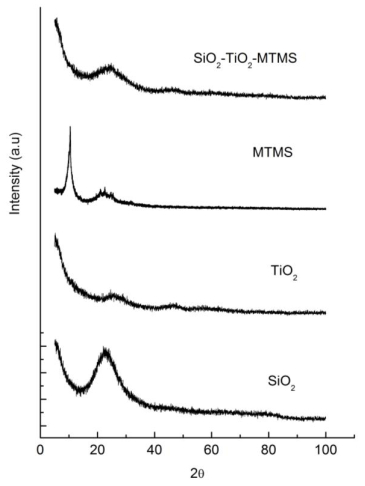









 DownLoad:
DownLoad:

